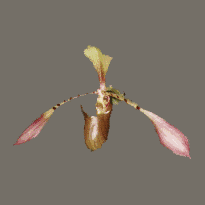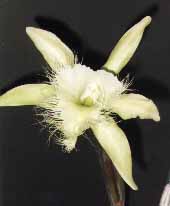 |
Rhyncholaelia (Brassavola) digbyana 'B'
At night, smells like lemon. Lots of light - more than cattleyas.
Grows outside in a semi-shaded patio, hung up high to maximize light.
This is the "B" in Blc cattleya hybrids,
and is the source of the frilly lip. (The genus was reclassified to Rhyncholaelia,
but Brassavola is still used for registration of hybrids)
|

|

|
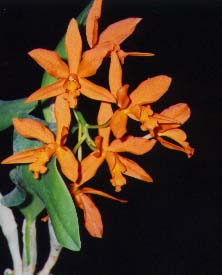 |
Lc.
Trick or Treat
Small, intense orange flowers
will last 6 weeks or more.
|
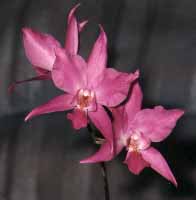 |
Laelia gouldiana
This vigorous species from Mexico hangs high in the
shaded patio. The flowers, on a long spike, have a pearl-like luster in
the sunlight.
|
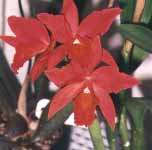 |
Slc. Jewel Box 'Scheherazade'
A little more shade than the oncidiums, but othewise
similar conditions. The Slc. hybrid is more tolerant of cool weather than
the standard cattleyas. The sophronitis and laelia ancestors both impart
cold-tolerance
|
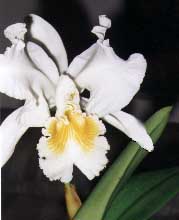 |
Cattleya June Bride
Big and fragrant. This one lives up to its name, blooming
late May/early June.
|
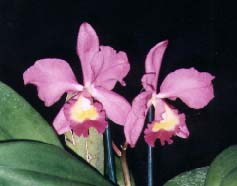 |
C. loddigesii x Slc. Jeweler's Art
This one is capable of blooming twice a year. It is extremelh
fragrant.
|
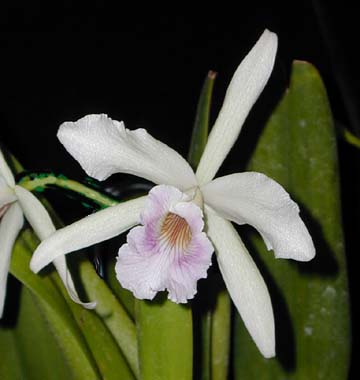 |
Laelia
crispa var. delicatissima
This elegant Laelia
has bloomed magnificently this year - 3 leads that each have 2-3 flowers!
it lives up to its name - the lip has a blush of delicate pink, with ark
purple veins, and a bright yellow throat. Photos don't quite do it justice.
|
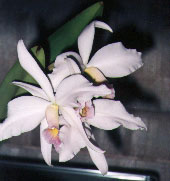 |
L.
anceps var 'Veitchiana' x C. labiata var. 'Coerulea'
I acquired this plant as a
rootless division, at a society meeting raffle table about 2 years ago.
It looked like it belonged on a mount, but the speaker suggested to me
that it would proably be too heavy for that. The pseudobulbs are about
6 inches (15 cm) long and thick, the leaves 10 inches (25 cm) beyond that.
I planted it in a mesh basket, since it seemed like it really wanted to
be free even if it wasn't mounted. I was so right... It now has beautiful
roots that extend as much as 18 inches (46 cm) below the pot. This plant
hangs high in my shaded patio, where it gets the maximum amount of sun
available in this area.
|
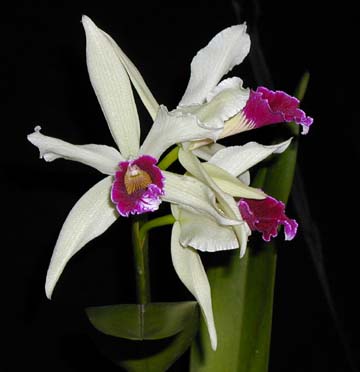 |
Laelia
purpurata
Another dramatic,
wonderful Laelia. Pure white flowers with a dark purple lip and yellow
throat with darker purple veining. Remember, all of these Laelia species
grow outside, and seem very happy to do so. No pampering needed. And fragrant,
too.
|
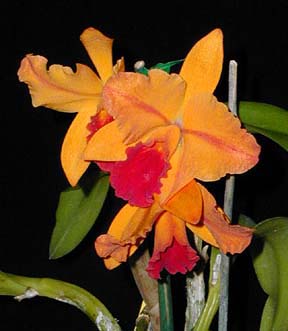 |
Slc.
Hazel Boyd 'Frae'
There is great variation in the color among different
clones of this wonderful grex. I have another one, that is deep red. The
Sophronitis imparts good cold tolerance.
|
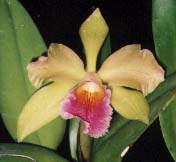 |
C. granulosa
x Blc. Ports of Paradise
This is a glowing example of just how adaptable these plants
are. I had been growing it indoors in the winter, and it bloomed. This
last winter (which was colder than usual - almost to freezing on a few
nights) I left it outside, due to space considerations. It did just fine,
and bloomed again. It was about two and a half months later than it had
been when grown indoors through the winter, but nearly all my plants were
late this year due to the cold winter. At any rate, it bloomed quite nicely.
|
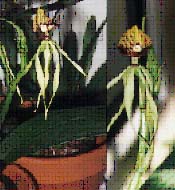 |
Encyclia cochleata
The "cockleshell orchid" or "octopus orchid"
puts out a succession of these colorful, intersting little flowers.
|
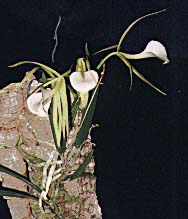 |
Brassavola nodosa
This year I had four of these delicate flowers growing from
this cork slab. The flowers are sweetly fragrant at night. South of the
border, this is known as "La dama de la noche". Need I say more?
|
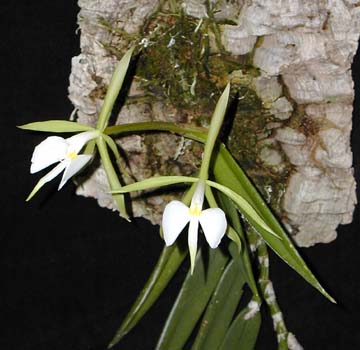 |
Epi.
parkinsonianum
This plant was a rootless cutting.
I mounted it, and it rooted and established itself quite quickly. The
leaves are very thick and succulent. The flowers have the fragrance of
cloves at night
|
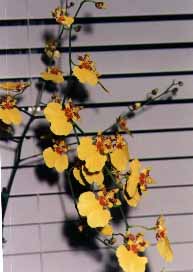 |
Oncidium Gower Ramsey
Sometimes known as "Dancing Ladies". This one grows
a spike of 4-5 feet (120-150 cm), and does it 3 times a year. It hangs
on the semi-shaded patio, in the wind and the rain, the heat and the cold.
Nothing seems to bother it.
|
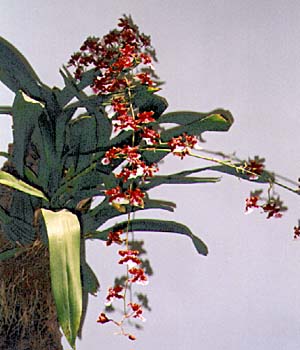 |
Oncidium Sharry Baby 'Sweet Fragrance'
Here's another oncidium. This one is growing on a cork slab,
on that shaded patio. It gets watered daily, but otherwise doesn't need
any more care than the Gower Ramsey. This plant has produced 4 spikes
this season, starting in mid-April. In mid-August, it is still in bloom.
It has the fragrance of chocolate - and none of the calories.
|
 |
Onc.
ornithorhyncum
A wonderfully fragrant species,
with multi-branched inflorescences. This one is in the ancestry of Sharry
Baby.
|
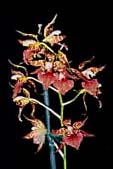 |
Lemboglossum
(bictoniense x cordaturm)
This is a primary hybrid of
two oncidium relatives, to make cool-growing, brilliant flowers with a
very characteristic heart-shaped lip.
|
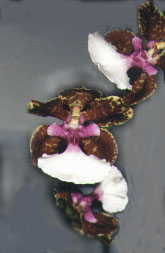 |
Onc. Maui Gold 'Lakeview' x lanceanum
One of the "mule-ear" type oncidiums. Flowers are
about 4 cm across.
|
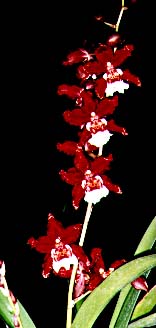 |
Vuylstekeara Linda Isler
Cochlioda x Miltonia x Odontoglossum gives tall multi-flowered
spike with dark color.
|
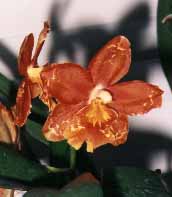 |
Odontocidium Tiger Butter
x Odondioda Rustic Red
Odontocidium is Odontoglossum x Oncidium, and Odontioda is
Odontoglossum x Cochlioda. This intergeneric likes it fairly cool, damp,
and shady. (Strong Odondoglossum influence)
|
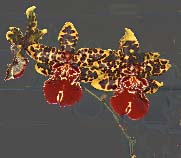 |
Colmanara Wildcat 'Doris'
Odcdm. Crowborough 'Spice Island' x Odtna. Rustic Bridge
'Hotlip'.
This one had a very grand 30" (80 cm) spike with around 32 flowers.
|
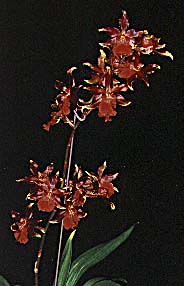 |
Colm.
Wildcat 'Jaguar'
The picture does not do it justice. Petals and sepals
are a rich chestnut-brown, with yellow tips.
|
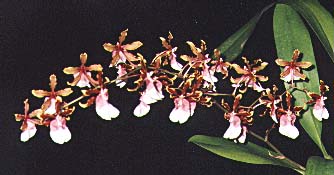 |
Mtdm.
Issaku Nagata 'R. L. Hammer'
Rich pink and gold in this Miltoniopsis - Oncidium
hybrid.
|
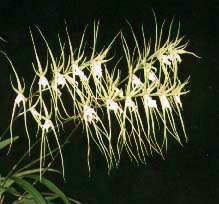 |
Brassia verrucosa
This is also known as the "spider orchid". It had
five spikes full of these spidery flowers last summer.
|
 |
Ada glumacea
The genus Ada is closely related to Brassia. The flowers
are smaller, and a bit more colorful. They also have a very powerful,
almost overwhelming, fruity fragrance.
|
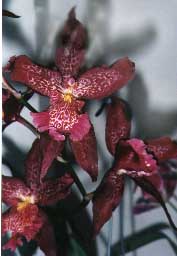 |
Beallara Marfitch 'Howard's Dream'
This one is contains Brassia x Cochlioda x Miltonia .x Odontoglossum.
It is (Mtssa. Charles M. Fitch x Oda. Fremar).and bloomed 5/98 with 2
spikes and a total of 8 flowers, each about 11 cm across (4.5 inches).
It bloomed again 12/98 with 10 flowers on one beautifully presented spike.
Magnificent!
|
 |
Odbrs. Kenneth Bivens
This spectacular intergeneric hybrid has deep mahogany
flowers with yettlow tips, and a fragrance of cedar.
|
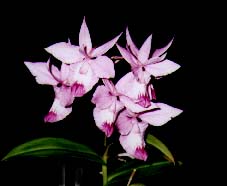 |
Barkeria Pink Papaya
This Epidendrum relative likes to live on a cork slab rather
than it a pot. It has copious roots that need to dry out between waterings.
It also prefers cool evenings, and goes nearly dormant during the winter.
|
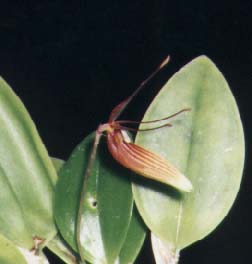 |
Restrepia antenniferia
These strange little flowers only last a few days,
but the plant puts out several of them in succession. It grows under Masdevallia
or Phragmipedium conditions - cool, shady, and damp
|
 |
Masdevallia Elven Gem
Masdevallias like it cool, shady, and damp. My shaded
patio has an area that meets these conditions fairly well. Watering is
especially important in the summer, to keep the temperature of the leaves
down as much as possible.
|
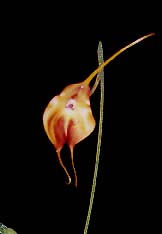 |
Masd. veitchiana
A masdevallia species that is native to the mountains
of Peru around Machu Picchu. This particular plant has flowers that are
a softer orange than is common for the the species, but also deep red
blush. They are relatively large (12 cm or more including the tails).
|
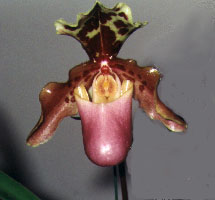 |
Paphiopedilum henryanum 'Spotted Gem' x 'Giant'
Paphs grow under conditions similar to Phrags, perhaps
a little brighter and not quite so wet.
|
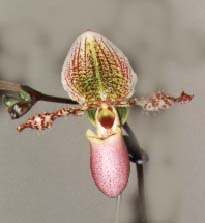 |
Paph glaucophyllum
A multifloral species. The flowers bloom successively. This
one came indoors for the winter - multiflorals like it a little warmer
than the single-floral solid-green-leafed Paphs.
|
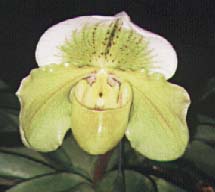 |
Paph.
Pekeruru (Paph. Via Victoria x Sheila Hanes)
The color is quite green when
it first opens, but becomes more yellow as the flower matures. A big,
substatial "toad" that does very well outside in the winter,
even when some of the more fragile Paphs move inside.
|
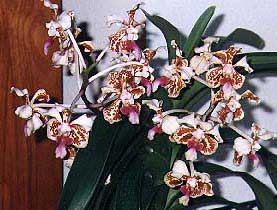 |
Vanda tricolor
While most vandas (and their relatives) are tricky
to grow without a greenhouse where I live, this one is doing beautifully.
It comes from higher elevations (around 1500 meters) so it is fairly cold-tolerant.The
flowers are fragrant and long-lasting. It needs plenty of water, since
it likes humidity, and likes to be fed regularly.. But although Vandas
tend to be warm growers, this one obviously had no objection to our cool
winter nights. It hangs high, so it gets the maximum amount of sun in
the shaded patio.
|
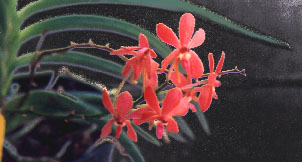 |
Ascofinetia
Peaches
The Neofinetia falcata parent
of this hybrid gives it excellent cold tolerance. It was outside all winter,
while I brought most of the vandadeous orchids inside when the night temperatures
dropped below 40 deg (4 deg C). This plant experienced temperatures almost
down to freezing (at least briefly) and clearly did not mind. It has 2
spikes this year.
|
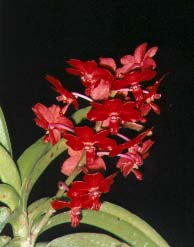 |
Ascocenda Red Gem
My biggest orchid triumph this year is the discovery that
I can not only grow, but also flower, vandaceous orchids. I did bring
them inside during the winter - this one was colder than usual - but put
them back outside when the danger of frost was past. While I knew that
V. tricolor (above) was fairly resistant to cold, this one was more marginal
- but clearly, it was satisfied with the conditions that I could give
it. Light and temperature range are both lower than would be ideal, but
they can, and do, adapt.
|
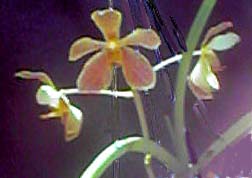 |
Paraphal.
Ponce es Ponce x Ascda. Motes Kalahari 'St. Thomas'
Another Vandaceous
triumph. I won this at a raffle table a year ago, had no idea what it
would look like. Now I know... and I love it. While the Paraphalaenopsis
parent is listed as "Phalaenopsis" in the literature, it is
much more closely related to the Vanda. The leaves are long and terete,
a characteristic inherited from the Paraphalaenopsis parent. This plant
definitely needs much less light than a terete-leaved Vanda. I brought
it inside during an unusually cold winter, along with most of the rest
of the vandaceous orchids, but in the spring it moved right back ouside.
|
![]()
![]()
